Thai Peanut Sauce Recipe
I have spent years perfecting this recipe, tasting peanut sauces at Thai restaurants all over the world, and honing in on what I think makes for the best ever peanut sauce. It is subtle creamy coconut, a hint of sesame, a little heat, plenty of lime juice, some sweetness, and of course plenty of garlic and ginger to compliment the nutty flavor of the peanut butter. This is it–my recipe for the Best Thai Peanut Sauce Ever.
Perfect for noodles, salads, lettuce wraps, spring rolls, coating your favorite protein, or as a dipping sauce! My favorite is to serve this Thai peanut sauce with Spring Rolls or Chicken Satay for a great meal.
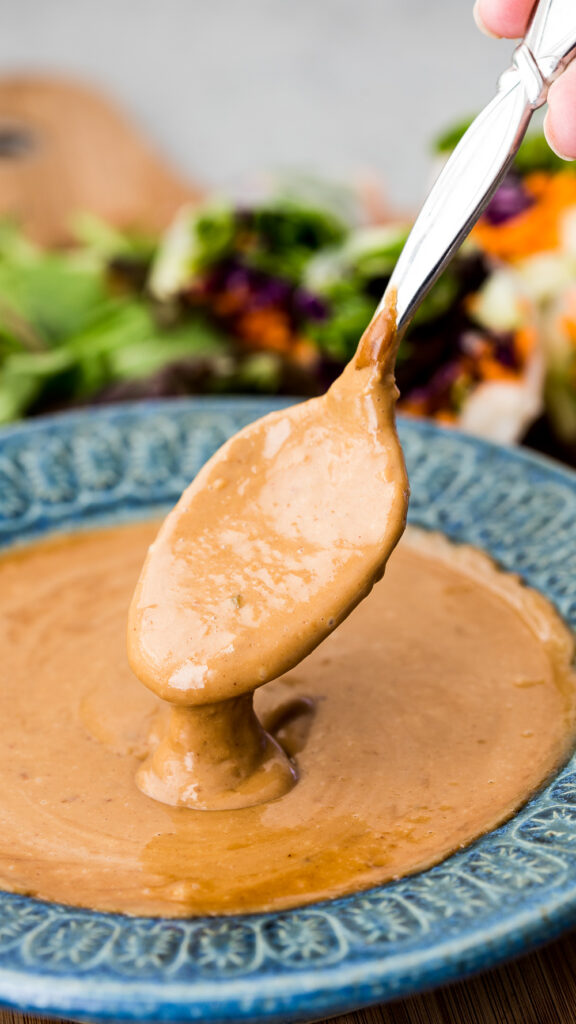
Smooth, delicious, easy to make peanut sauce that goes with just about everything. We keep a jar of this in the fridge for dipping veggies, eating with spring rolls, chicken satay, for putting on top of noodles, stir fries, and even to use as a salad dressing.
The flavor is unbeatable with gingery, garlicky goodness, a subtle kick from chili sauce, and naturally sweet and delicious peanut butter and sesame, this peanut sauce will quickly become a fan favorite in your home too. I am sure of it.
When I need a little flavor, or don’t know what to make for dinner, this peanut sauce comes to the rescue.
What to Use Peanut Sauce For
Thai peanut sauce is the ultimate condiment, and there is a reason I make it regularly and you can almost always find it in my fridge. It is flavorful, tasty, fun, and can be used in a variety of ways to elevate a number of meals. Here are some of my favorite uses:
- Stir-Fries: Grab whatever veggies you have in your fridge, and start a stir fry, then simply spoon in some of this Thai peanut sauce to quickly add flavor. It pairs super well with veggies, chicken, and shrimp!
- Noodles: Make a quick pad thai with this peanut sauce as a sub. Simply cook up your rice or soba noodles, then coat them with this peanut sauce, top with chopped herbs, crushed peanuts, and some lime wedges for a totally satisfying meal.
- Salad Dressing: This peanut sauce is a little thicker, so simple thin it out with some hot water, some coconut milk, or even extra lime juice to make a totally tasty salad dressing. Just drizzle it over your favorite mixed greens, add some veggies, maybe even some mandarin oranges and roasted chicken or shrimp for a perfectly delicious Asian-inspired salad.
- Spring Rolls or Summer Rolls: Hands down my favorite way to use peanut sauce is as a dip for spring or summer rollas. Get rice paper, and fill it with shrimp, mangos, lettuce, mint, rice noodles, etc. and wrap them up tight, then serve with this peanut sauce for the ultimate dipping experience.
- Satay Skewers: Marinate chicken, beef, or tofu in thinned out peanut sauce before grilling or baking, and then serve with a little more peanut sauce for a tasty appetizer or meal.
- Rice Bowls: Use peanut sauce as the topping for your favorite rice bowl. Layer rice, veggies, and protein, then drizzle with this peanut sauce.
- Buddha Bowls: Load a bowl up with a variety of grains, vegetables, and protein then drizzle it with peanut sauce for a Thai inspired meal.
- Sandwiches and Wraps: Use this peanut sauce as the spread on your tortillas, bread, etc. for sandwiches and wraps that are Asian inspired.
- Baked Sweet Potatoes: Skip the marshmallows or honey butter, and instead drizzle peanut sauce over roasted or baked sweet potatoes. It is amazing.
- Sushi Rolls: Skip the soy sauce, and instead add flavor and fun by using peanut sauce as a dipping sauce for sushi rolls. Kids love it.
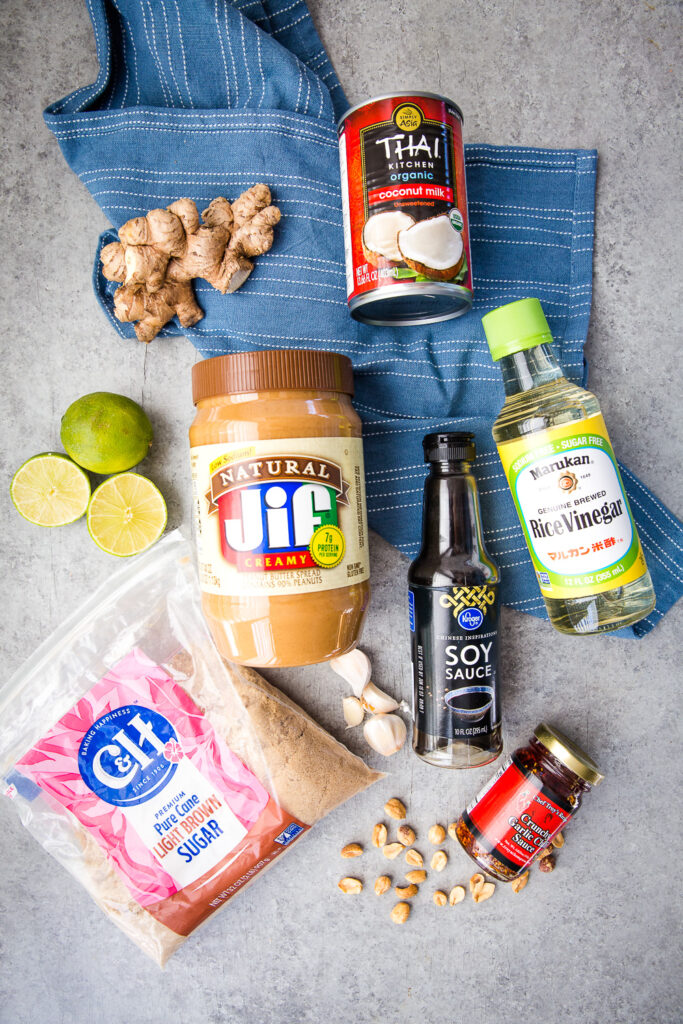
What You Need to Make Peanut Sauce
All of the ingredients needed for Thai Peanut Sauce are easy to find, and can be picked up at a general grocery store:
- Peanut butter. Look for a smooth peanut butter without any added sugar, usually called “natural” peanut butter. If you can’t find it or want to use full sugar peanut butter, skip the brown sugar. The natural peanut butter gives you the chance to adjust the sweetness of the sauce to your preference, instead of getting hit over the head with sweet from the peanut butter.
- Sesame Oil: The rich nutty flavor of sesame oil adds a wonderful richness to this sauce. You can use toasted sesame oil or regular. Both are great.
- Soy sauce. This adds a salty, umami flavor. You may find it is too salty, so the low sodium option is great, and if you need gluten-free, try Tamari sauce or coconut liquid aminos. Liquid aminos are great soy-free alternatives.
- Sugar. I have tested this recipe with a lot of sweetner options, from maple syrup to agave, brown sugar works best. But if you want a healthier alternative or make it fit a dietary restriction like low carb, you can sub other sweeteners.
- Crunchy Chili Garlic Sauce. This spicy garlicky condiment should not be skipped, it helps bring as much or as little heat as you’d like, for an extra kick, and gives it extra flavor. If you can’t find it, sriracha also works.
- Rice vinegar. This gives your peanut sauce the acidic component to help cut through some of the oily richness of the peanut butter. Rice vinegar adds the perfect flavor.
- Lime juice: Fresh lime juice is similar to the rice vinegar as it is an acid that helps cut through the sweetness and fatty or oily ingredients, and gives it a light, delightful flavor.
- Garlic and Ginger. Fresh garlic is best, and fresh ginger. I love using the fresh ginger paste to make things faster.
- Coconut Milk. This helps to thin out the sauce until it is a good consistency for dipping or drizzling, and gives it a nice creaminess and subtly coconut flavor.
Recommended Equipment For This Thai Peanut Sauce Recipe
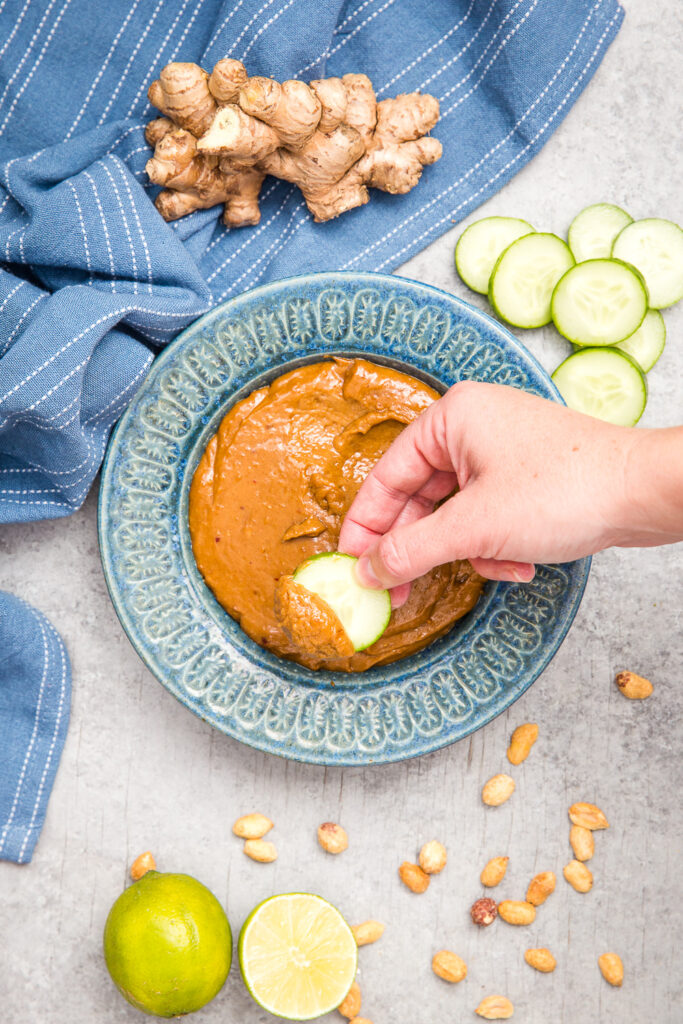
How to Make Thai Peanut Sauce
Origin of Peanut Sauce: Peanut sauce actually originated in Indonesia (source). But it is so commonly called Thai peanut sauce, that we are calling it by what it is known as, just so you know! But not matter what you call it, it is delicious and easy to make, here’s how:
Step One: Combine Ingredients in Food Processor except Coconut Milk or Warm Water
Put all of the ingredients together in a food processor bowl, or use a big bowl and a wire whisk.
Process or whisk until combined.
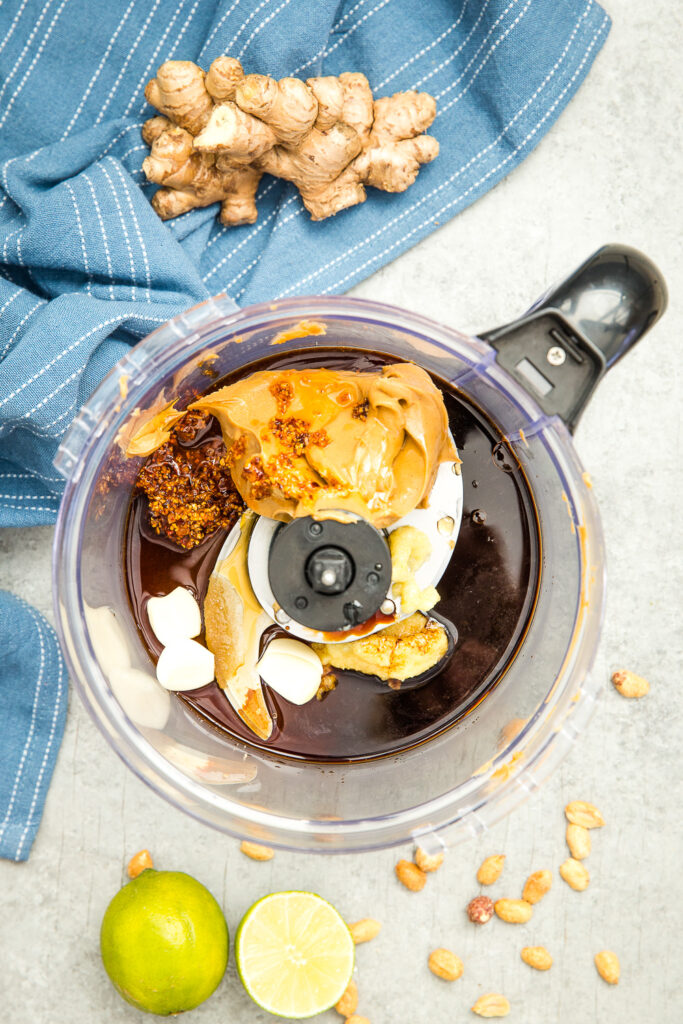
Step Two: Thin with Coconut Milk to Desired Consistency
Once you have everything combined, use the coconut milk to thin it out to the desired consistency depending on how you plan to use it. This usually takes between 2-4 Tablespoons of liquid, but feel free to adjust to your preference.
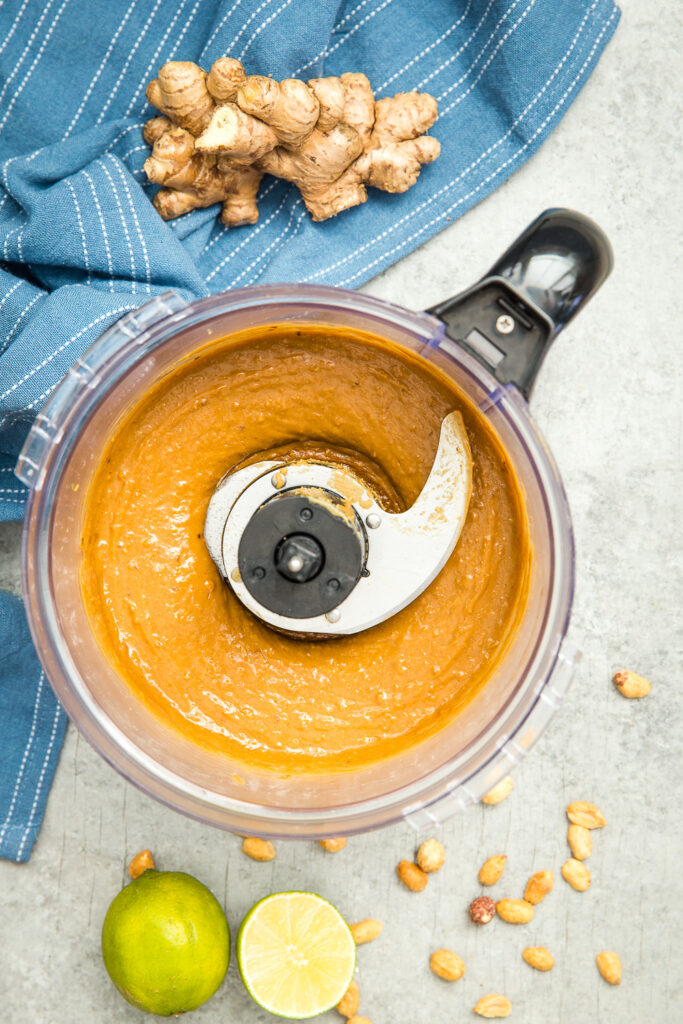
Step Three: Taste and Adjust as Needed
The fun thing about this sauce is you can adjust it as you see fit. You can make it spicier, sweeter, tangier, etc. For added sweetness use more brown sugar. For heat use chili garlic sauce. For more acidity use lime juice. For saltiness use more soy sauce. To thin the peanut sauce use more coconut milk. If sauce has become too thin, add more nut butter. You get the idea!
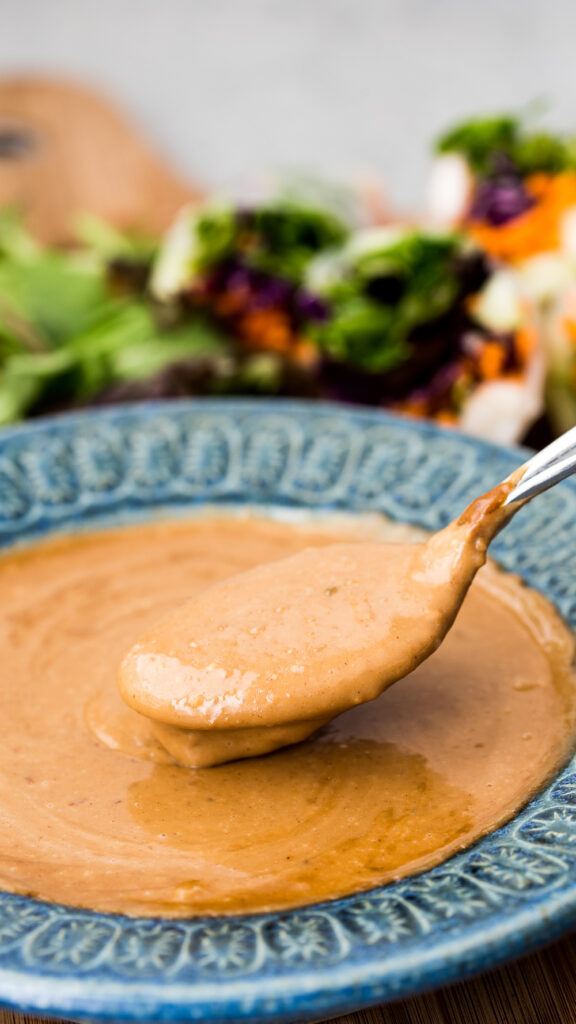
Dietary Modifications
This recipe for peanut sauce is vegetarian and vegan, however, if you have other dietary requirements, here are a few substitutions you can make:
- Gluten-Free: Substitute soy sauce for a gluten-free variety, or for Tamari sauce, or coconut liquid aminos.
- Peanut-Free: I mean, it is peanut sauce, but the fun thing is, you can make it with other nut butters if you have a peanut allergy. It will change the flavor, but you can use almond or cashew butter.
- Low-Carb: Instead of sugar, use a non-nutritive sweetener such as stevia extract.
- Soy-Free: Substitute the soy sauce or Tamari sauce for coconut liquid aminos, which bear a similar taste without the soy.
- Refined Sugar-Free: Sub in maple syrup, honey, agave nectar, or coconut sugar for the brown sugar. Or skip the sugar, but just know it won’t be as good.
How do you thicken peanut sauce?
Before it has been thinned out with the coconut milk, peanut sauce has a pretty thick consistency. The problem can be that sometimes in your attempt to thin it, you thin it a bit too much. Here are a few fixes for this:
- Put it in the fridge for a short amount of time to solidify it some.
- Whisk in a little more peanut butter to thicken it back up.
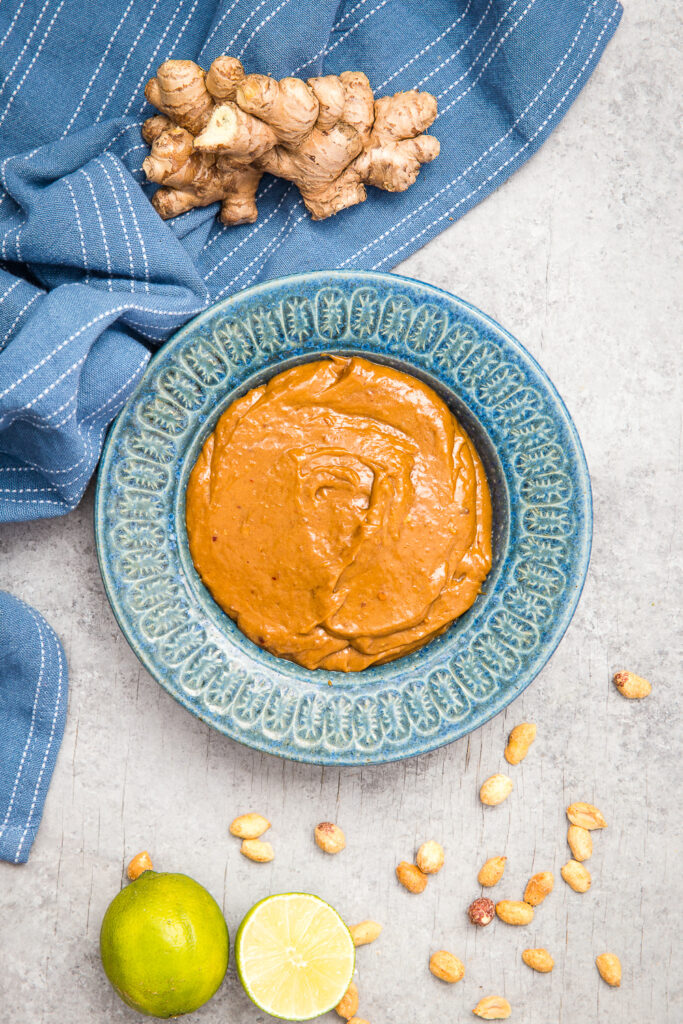
Serve With
This recipe is so perfect for just about everything from appetizers to main dishes. Here is what I like to serve it with:
- Spring Rolls
- Lettuce Wraps
- Salad
- Noodles
- Chicken Satay
- Stir Fry
- Veggies
- Coconut Shrimp
Tips and Tricks
Making this recipe is Eazy Peazy, but here are a few tips to simplify making it:
- Warm it up. If you aren’t using a food processor, the best way to get it to mix together well is to pop the peanut butter in the microwave for 10-20 seconds, so it is warm, and stirs together more easily.
- Prep in bulk. You are going to love this sauce, and while it is super easy to make, it is nice to have it on hand, and the awesome thing is, peanut sauce reheats beautifully! Double or triple your batch, and portion it out and freeze it until you are ready to use it.
- Adjust Flavors Gradually. It is so nice that you can customize this sauce to your preference, especially your heat preference, but do it gradually. Add a little garlic chili sauce at a time until you get the desired level of spice. Same with brown sugar etc.
- Make it creamy. When tossing with noodles or salads, add extra coconut milk to get a creamy, pourable dressing.
- Experiment with flavors. Changing the ratios of ingredients can yield different results, so experiment and have fun adjusting to your preferences.
Make Ahead and Storage
How to make this recipe ahead of time:
- To Prep-Ahead: Homemade peanut sauce can be prepared up to 1 week in advance, however the sauce will gradually start to break down over time, and the fresh components can go bad. I recommend making it no more than 3-4 days ahead for best results.
- To Store: Prepared peanut sauce can be kept in an airtight container in the fridge for up to 1 week.
- To Freeze: This one freezes really well, prep sauce in airtight, freezer-safe containers, and freeze for up to 4-6 months.
- To Reheat: Stored peanut sauce may be left out on the counter for an hour before serving, or microwaved in the oven for 10-20 seconds to make it smooth and creamy. Stir or whisk it back together to make sure it is not separated.
Other Great Recipes:
- Thai Peanut Skillet Chicken
- Pad See Ew
- Easy Chicken Stir Fry
- Chicken Lettuce Wraps (PF Chang’s Copycats)
- Mango Shrimp Lettuce Wraps
WANT MORE EZPZ? Subscribe to my newsletter and follow along on Facebook, Pinterest and Instagram for all of the latest updates.
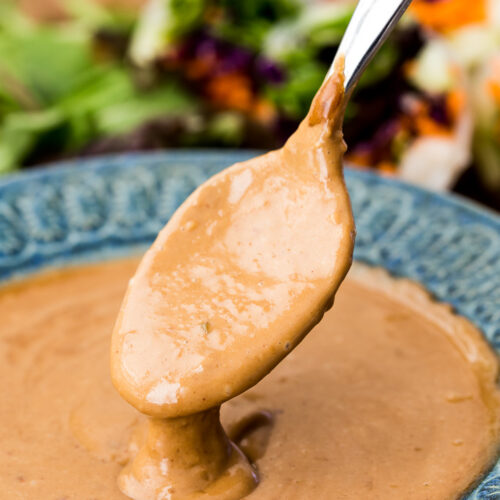
Thai Peanut Sauce
Ingredients
Peanut Sauce Recipe Ingredients
- 1/2 cup peanut butter Natural
- 2 tablespoons soy sauce low sodium is best, use tamari or coconut aminos for gluten free
- 1 tablespoon rice vinegar
- 1 teaspoon sesame oil
- 2 tablespoons brown sugar
- 2 teaspoons crunchy chili garlic sauce more or less to taste
- 1 tablespoon fresh lime juice
- 3 garlic cloves pressed or grated
- 1 tablespoon ginger root grated or minced, or use ginger paste
- 1/4-1/2 cup coconut milk can sub warm water
Instructions
Making Peanut Sauce
- To a medium mixing bowl or food processor bowl, add peanut butter, soy sauce, rice vinegar, sesame oil, brown sugar, lime juice, garlic chili sauce, fresh garlic, fresh ginger and whisk or pulse to combine.
- Add coconut milk or water 1 tablespoon at a time until a thick but pourable sauce is achieved. I normally use 2 about tablespoons for a dipping sauce and up to 4 if using it for a dressing. Can add more if needed for desired consistency.
- Taste and adjust seasonings as needed. See notes.
- Store leftovers in an airtight container in the refrigerator up to 1 week.
Notes
For heat use chili garlic sauce
For more acidity use lime juice
For saltiness use more soy sauce.
To thin sauce use more coconut milk.
If sauce has become too thin, add more nut butter. To get the right consistency, stir in coconut milk until it is how you want it. If refrigerated, warm in the microwave for 10 seconds before serving to thin it back out some, as the peanut butter will solidify and it will be very thick.
Nutrition
Our recipe card software calculates these nutrition facts based on averages for the above ingredients, different brands, and quality of produce/meats may have different nutritional information, always calculate your own based on the specific products you use in order to achieve accurate macros for this recipe.
Pin to your Dips and Dressings board on Pinterest:
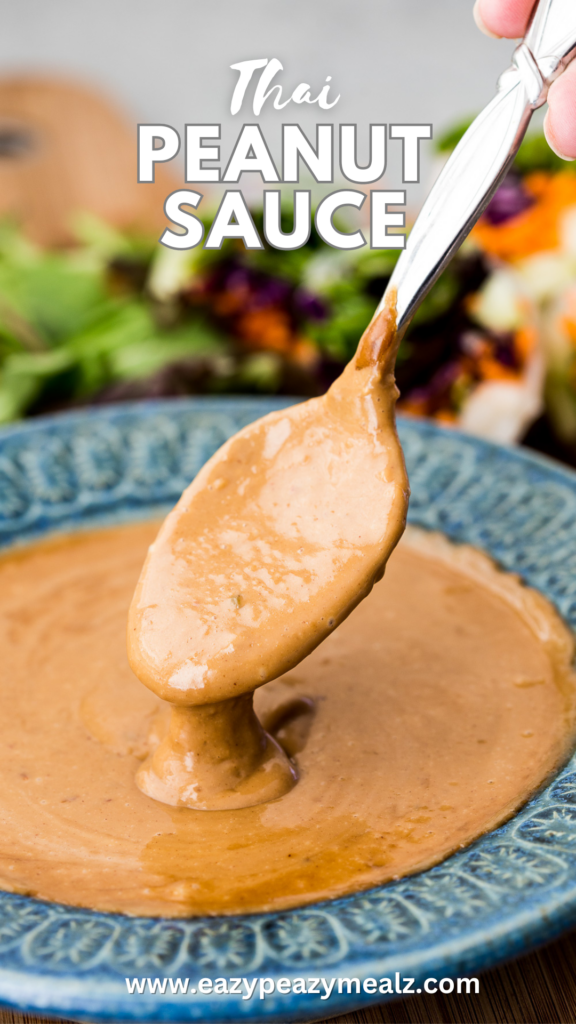


Leave a Reply